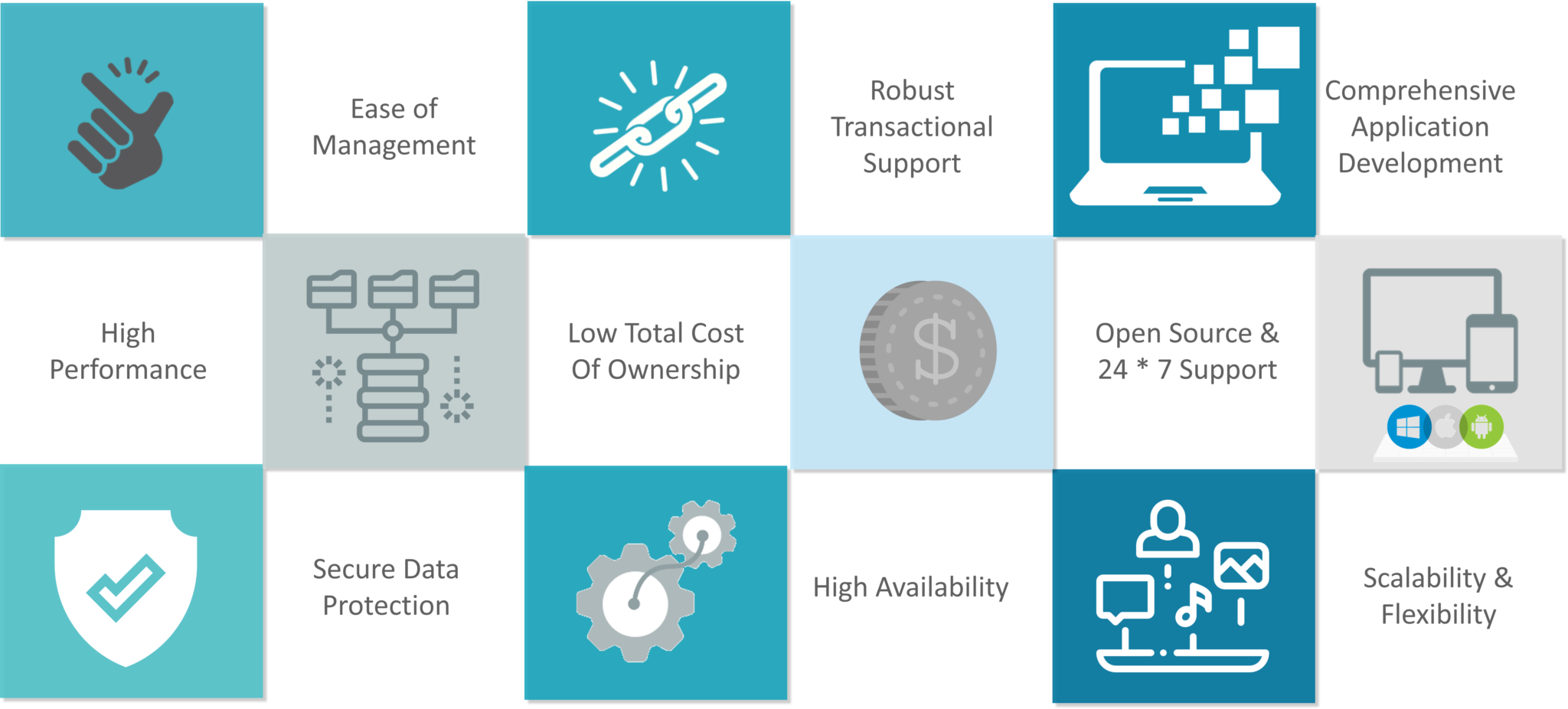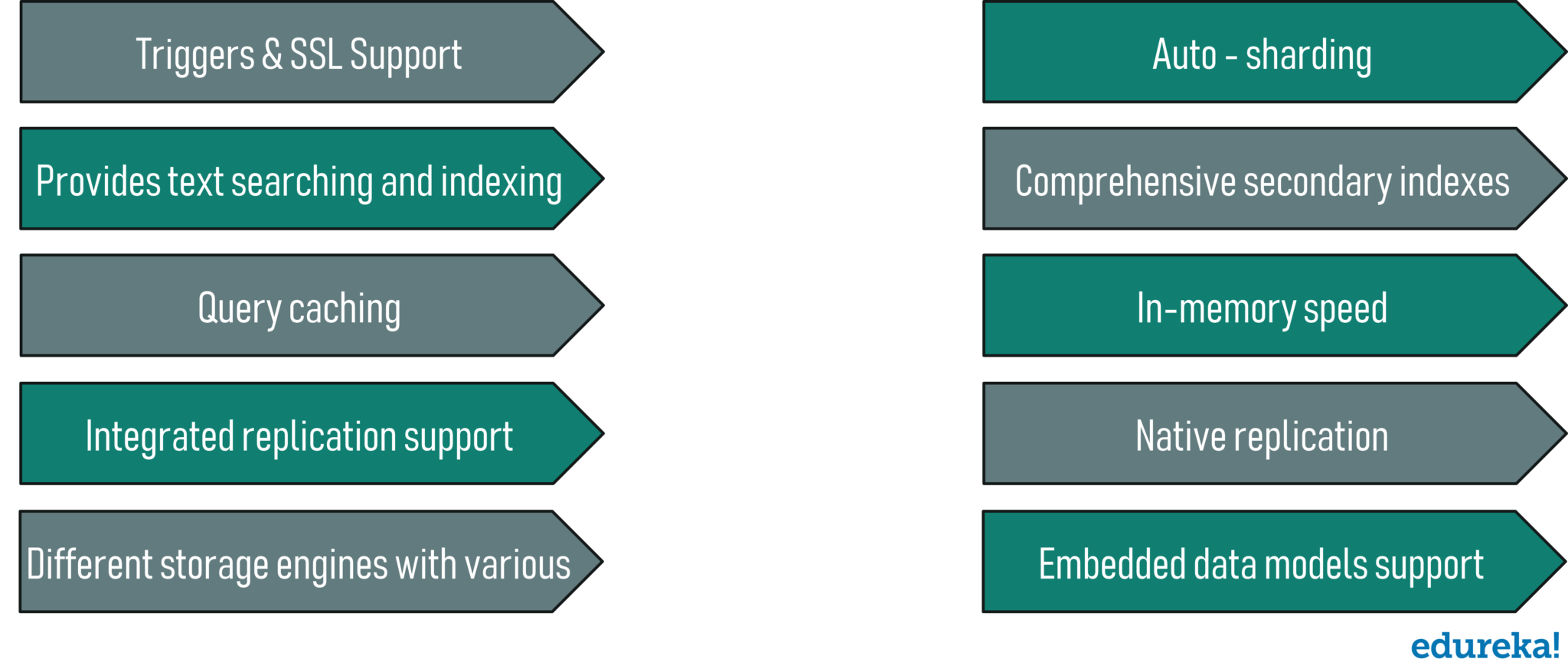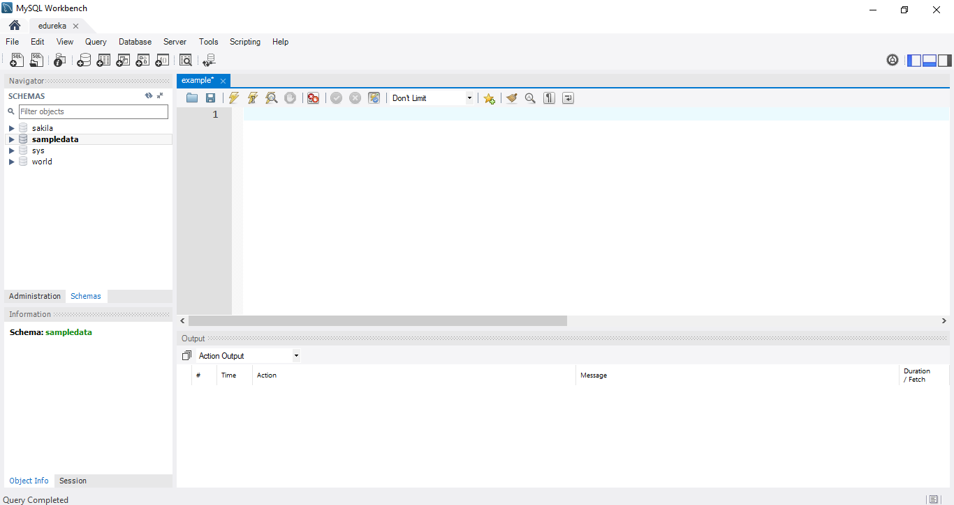Microsoft SQL Server Certification Training
- 6k Enrolled Learners
- Weekend/Weekday
- Live Class
With the amount of data present in the world, it is almost next to impossible, to manage data without proper databases. In today’s market, there are different kinds of databases present, and deciding on the best database which suits your business can be an overwhelming task. So, in this article on SQL vs NoSQL, I will compare these two type of databases to help you choose which type of database can help you and your organization.
So, let us get started, folks!!
SQL aka Structured Query Language is the core of the relational database which is used for accessing and managing the databases. This language is used to manipulate and retrieve data from a structured data format in the form of tables and holds relationships between those tables. The relations could be as follows:
Now, next in this article let us understand what is NoSQL?
NoSQL, or most commonly known as Not only SQL database, provides a mechanism for storage and retrieval of unstructured data. This type of database can handle a humongous amount of data and has a dynamic schema. So, a NoSQL database has no specific query language, no or a very few relationships, but has data stored in the format of collections and documents.
So, a database can have a ‘n’ number of collections and each collection can have ‘m‘ number of documents. Consider the example below.

As you can see from the above image, there is an Employee Database which has 2 collections i.e. the Employee and Projects Collection. Now, each of these collections has Documents, which are basically the data values. So, you can assume the collections to be your tables and the Documents to be your fields in the tables.
Alright, So, now that you know what is SQL & NoSQL, let us now see, how these databases stand against each other.
So, in this face off, I will be comparing both these databases based on the following grounds:
SQL is called a relational database as it organizes structured data into defined rows and columns, with each table being related to the other tables in the database.
NoSQL, on the other hand, is known as a non-relational database. This is because data is stored in the form of collections with no or few relations between them.
SQL needs a predefined schema for structured data. So, before you start using SQL to extract and manipulate data, you need to make sure that your data structure is pre-defined in the form of tables.
However, NoSQL, have a dynamic schema for unstructured data. So, if you are using a NoSQL database, then there is no pre-defined schema present, and the complete schema of your data completely depends upon how you wish to store data. i.e. which fields do you want to store in documents and collections.
The SQL databases are table based databases. So, you can have ‘n’ number of tables related to each other and each table can have rows and columns which store data in each cell of the table.
Now, if we talk about NoSQL Databases, then NoSQL databases have the following categories of databases:
So, SQL databases store data in the form of tables and NoSQL databases store data in the form of key-value pair, documents, graph databases or wide-column stores.
SQL is a better fit for complex query environment when compared to NoSQL as the schema in SQL databases is structured and has data stored in a tabular format. So, even if you wish to apply nested queries with many subqueries inside the outer query, you can easily do by using the proper table and column names.
Now, the reason why NoSQL databases isn’t a good fit for complex queries is because the NoSQL databases aren’t queried in a standard language like SQL.
Well, when we compare the databases on this factor, NoSQL fits better for hierarchical storage when compared to SQL databases.
This is because as the number of tables increases, the complexity of maintaining relations between them also keeps increasing. So, in such a scenario, you cannot relate the humongous amount of tables with many columns in them to each other. But, when you consider a NoSQL database, this kind of database fits better for the hierarchical data storage as it follows the key-value pair way of storing data which is similar to JSON data.
The SQL databases are vertically scalable. You can load balance the data servers by optimizing hardware such as increasing CPU, RAM, SSD, etc.
On the other hand, NoSQL databases are horizontally scalable. You can perform load balancing by adding more servers to your cluster to handle a large amount of traffic.
The SQL databases have a specific language, and it does not vary from databases to databases. This kind of databases uses the SQL ( Structured Query Language ) for retrieving and manipulating the data.
The NoSQL databases have no specific language used for queries, and it varies from database to database. In the NoSQL database, the queries are mainly focused on the collection of documents and the language is known as UnQL (Unstructured Query Language).
On comparing SQL and NoSQL, based on this factor, SQL databases are used for heavy-duty transactional type applications. Well, this is because SQL provides atomicity, integrity, and stability of the data. Also, you can use NoSQL for transactions purpose, but, it is still not stable enough in high load and for complex transactional applications. So, you can understand that SQL is mainly used for OLTP(Online Transactional Processing) and NoSQL is mainly used for OLAP(Online Analytical Processing).
SQL databases are based on ACID properties ( Atomicity, Consistency, Isolation, and Durability) whereas the NoSQL databases are based on the Brewers CAP theorem ( Consistency, Availability, and Partition tolerance ).
Let me explain you the ACID properties first:
Brewers CAP Theorem states that a database can only achieve at most two out of three guarantees: Consistency, Availability and Partition Tolerance. Here
NoSQL can not provide consistency and high availability together.
All the SQL vendors offer excellent support since SQL has been into existence for more than the past 40 years. However, for some NoSQL database, only limited experts are available and you still have to rely on community support to deploy your large scale NoSQL deployments. This is because NoSQL has come into existence in the late 2000s and people haven’t explored it yet much.
So, if I have to summarize the differences for SQL and NoSQL in this article on SQL vs NoSQL, you can refer to the below table.
Table 1: Differences between SQL and NoSQL – SQL vs NoSQL
So, folks, with this we come to an end of this face-off between SQL and NoSQL. Now, that we have discussed so much about SQL and NoSQL, let me show you some examples of the same.
Examples of SQL and NoSQL are as follows:

Now, the most popular databases from SQL and NoSQL are MySQL and MongoDB.
So, next in this article on SQL vs NoSQL, we will be comparing MySQL and MongoDB. But, before that, you can also go through this video on SQL vs NoSQL.
This Edureka video on SQL vs NoSQL will discuss the differences between SQL and NoSQL. It also discusses the differences between MySQL and MongoDB.
 What is MySQL?
What is MySQL?MySQL is an open-source relational database management system that works on many platforms. It provides multi-user access to support many storage engines and is backed by Oracle. So, you can buy a commercial license version from Oracle to get premium support services.
The following are the features of MySQL:


Next, in this article let us understand what is MongoDB?
MongoDB is a non-relational database which stores the data in documents. This type of database stores the related information together for quick query processing.
The features of MongoDB are as follows:
Alright, So, now that you know what is MySQL & MongoDB, let us now see, how these databases stand against each other.
So, in this face off, I will be comparing both these databases based on the following grounds:
MySQL uses the Structured Query language(SQL). This language is simple and consists of mainly DDL, DML DCL & TCL commands to retrieve and manipulate data. MongoDB, on the other hand, uses an Unstructured Query Language. So, the query language is basically the MongoDB query language. Refer to the image below.
 Flexibility of Schema
Flexibility of SchemaMySQL has good flexibility of schema for structured data as you just need to clearly define tables and columns. Now, MongoDB, on the other hand, has no restrictions on schema design. You can directly mention, a couple of documents inside a collection without having any relations between those documents. But, the only problem with MongoDB is that you need to optimize your schema based on how you want to access the data.
On comparing MySQL and MongoDB based on this factor, MySQL support relationships with the help of JOIN statements but MongoDB does not support the JOIN statements. But, it supports placing one document inside another document (also known as the embedding of documents) and multi-dimensional data types such as arrays.
MySQL basically uses a privilege-based security model. This kind of security model authenticates a user and facilitates the user privileges on a particular database.
MongoDB, on the other hand, uses a role-based access control with a flexible set of privileges providing security features such as authorization, and authentication.
On comparing MySQL and MongoDB on this parameter, let me tell you that MySQL is quite slow in comparison to MongoDB when large databases are considered. This is mainly due to because MySQL cannot be used for large and unstructured amounts of data.
However, MongoDB has the ability to handle large unstructured data. So, it is faster than MySQL where large databases are considered as it allows users to query in such a way that the load on servers are reduced.
Well, both of them offer excellent support 24*7 for security fixes, maintenance releases, bug fixes, patches, and updates. So, there is as such no difference between both of them based on this parameter.
You can refer to the following image for the key features of MySQL and MongoDB:
 Replication
ReplicationMySQL supports master-slave replication and master-master replication. MongoDB, on the other hand, supports built-in replication, sharding, and auto-elections. So, with the help of auto-elections in MongoDB, you can set up another or secondary database to automatically take over if the primary database fails.
You can refer to the following image for understanding where to use MySQL and MongoDB:

On comparing MySQL with MongoDB based on this factor, MySQL databases offer a better community than MongoDB as it is owned, and maintained by the Oracle Corporation.
So, if I have to summarize the differences between MySQL and MongoDB, you can refer to the below table.
| Key Areas | MySQL | MongoDB |
| Query Language | Uses Structured Query Language(SQL) | Uses MongoDB Query Language |
| Flexibility of Schema | Pre-defined schema design | No restrictions on schema design |
| Relationships | Supports JOIN statements | Does not support JOIN statements |
| Security | Uses privilege-security based model | Uses role-based access control |
| Performance | Slower than MongoDB | Faster than MySQL |
| Support | Provides excellent support 24*7 | Provides excellent support 24*7 |
| Key Features |
|
|
| Replication | Supports Master-Slave Replication | Supports built-in replication, sharding, and auto-elections. |
| Usage |
|
|
| Active Community | Has a good active community. | The community of MySQL is much better than that of MongoDB. |
Table 2: Differences between MySQL and MongoDB – SQL vs NoSQL
So, folks, with this we come to an end of this face-off between MySQL and MongoDB. Now, knowing so much more about MySQL and MongoDB might have raised a question on your mind i.e.Wether businesses should go for MySQL or MongoDB?
Well, there is no clear winner between both of them. The choice of database completely depends upon the schema of your database and how you wish to access it. Nevertheless, you can use MySQL when you have a fixed schema, high transaction, low maintenance, data security with a limited budget and MongoDB while you have an unstable schema, high availability, cloud computing, with in-built sharding.
So, there won’t be any final verdict as to which among them is the best as each one of these excel based on your requirement.
Now, that you know the differences between MySQL and MongoDB, next in this article on SQL vs NoSQL let me show you how to insert data into tables and collections in MySQL Workbench and MongoDB Compass respectively.
Let us start with inserting data into a table using MySQL Workbench.
To insert data into tables using MySQL Workbench, you can follow the below steps:
Step 1: Open MySQL Workbench and create a connection. To know how to create a connection, you refer to the MySQL Workbench Tutorial.
Step 2: Now, once your connection has been created, open your connection and then you will be redirected to the following dashboard.
 Step 3: Now to create a database and a table, follow the below queries:
Step 3: Now to create a database and a table, follow the below queries:
//Create Database CREATE DATABASE Employee_Info; //Use Database USE Employee_Info; //Create Table CREATE TABLE Employee (EmpID int, EmpFname varchar(255), EmpLname varchar(255), Age int, EmailID varchar(255), PhoneNo int8, Address varchar(255));
Step4: Now, once your table is created, to insert values into the table, use the INSERT INTO syntax as below:
//Insert Data into a Table
INSERT INTO Employee(EmpID, EmpFname, EmpLname,Age, EmailID, PhoneNo, Address)
VALUES ('1', 'Vardhan','Kumar', '22', 'vardy@abc.com', '9876543210', 'Delhi');
Step 5: When you view your table, you will the output as below.
 Now, next in this article on SQL vs NoSQL, let us see how to create database and collections in MongoDB Compass.
Now, next in this article on SQL vs NoSQL, let us see how to create database and collections in MongoDB Compass.
To insert data into tables using MongoDB Compass, you can follow the below steps:
Step 1: Open MongoDB Compass and create a host. Once your host is created click on Connect. Refer below.
 Step 2: Now, once your host is connected, to create a database, click on the Create Database option and mention the Database and the Collection Name.
Step 2: Now, once your host is connected, to create a database, click on the Create Database option and mention the Database and the Collection Name.
Step 3: Now, open your database, and choose the collection. Here I have chosen samplecollection. To add documents into the collection, choose the Insert Document option and mention the parameters. Here I have mentioned the EmpID and EmpName.

Now with this, we come to an end of this comparison on SQL vs NoSQL. I Hope you guys enjoyed this article and understood all the differences. So, if you have read this, you might have a clear idea about which database will suit your needs.
Now that you have understood the comparison between SQL & NoSQL, check out the MySQL DBA Certification Training & MongoDB Certification Training by Edureka, a trusted online learning company with a network of more than 250,000 satisfied learners spread across the globe.
Got a question for us? Please mention it in the comments section of “SQL vs NoSQL” and we will get back to you.
 Thank you for registering Join Edureka Meetup community for 100+ Free Webinars each month JOIN MEETUP GROUP
Thank you for registering Join Edureka Meetup community for 100+ Free Webinars each month JOIN MEETUP GROUPedureka.co